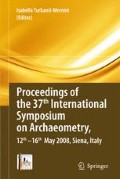Abstract
The term “Post-Byzantine art” refers to an artistic movement that appeared in the mid-fifteenth century and lasted until the early nineteenth century (Clogg 2002). The movement started immediately after the fall of the Byzantine Empire in 1453 and it marked the beginning of one of the most important periods in Greek art history. The Post-Byzantine era represented a transitional period when the art of panel painting changed style, from religious to secular, due to significant exchanges with the western world. At the same time, the artists’ technique evolved; the painters changed their method from egg tempera on wooden panel to oil painting on canvas. Cultural influences also brought changes in the iconographic types: the artists exempted themselves from the strict Byzantine rules of depiction, in order to allow themselves free expression.
Access this chapter
Tax calculation will be finalised at checkout
Purchases are for personal use only
References
Casoli A, Palla G, Tavlaridis J (1998) Gas-chromatography/mass spectrometry of works of art: characterisation of binding media in post-Byzantine icons. Stud Conserv 43:150–158
Cennini d’Andrea C 1437 (1954) Il libro dell’arte o trattato della pittura. English edition:The book of art, a treatise of painting. (Trans Thompson DV Jr), Dover, New York
Clogg R (2002) A concise history of Greece, 2nd edn. Cambridge University Press, Cambridge
Ek Fourna D (1906) H εϱμηνεία της ζωγϱαϕικής τέχνης. English edition: The interpretation of the art of painting. Papadopoulou-Kerameos (ed) B Kirschbaum, Petroupoli
Kouloumpi E, Lawson G, Pavlidis V (2006) The contribution of gas chromatography to the resynthesis of the Post-Byzantine artist’s technique. Anal Bioanal Chem 387(3):803–812
Acknowledgments
This work was carried out at De Montfort University, United Kingdom, and at the National Gallery of Greece. Our gratitude is extended to Dr M. Doulgeridis (NGA), Panagiotis Asimakopoulos (Perkin Elmer) for GC support, Peter Vandenabeele (University of Ghent) for carrying out the Raman spectroscopy, and finally Agni Terlixi (NGA) for the analysis of the cross-sections.
Author information
Authors and Affiliations
Corresponding author
Editor information
Editors and Affiliations
Rights and permissions
Copyright information
© 2011 Springer Berlin Heidelberg
About this paper
Cite this paper
Kouloumpi, E., Lawson, G., Pavlidis, V. (2011). Integrated Research on Sixteenth to Early Nineteenth Century Panel Paintings: Chromatographic and Spectroscopic Characterisation of Paint Layers. In: Turbanti-Memmi, I. (eds) Proceedings of the 37th International Symposium on Archaeometry, 13th - 16th May 2008, Siena, Italy. Springer, Berlin, Heidelberg. https://doi.org/10.1007/978-3-642-14678-7_33
Download citation
DOI: https://doi.org/10.1007/978-3-642-14678-7_33
Published:
Publisher Name: Springer, Berlin, Heidelberg
Print ISBN: 978-3-642-14677-0
Online ISBN: 978-3-642-14678-7
eBook Packages: Earth and Environmental ScienceEarth and Environmental Science (R0)

